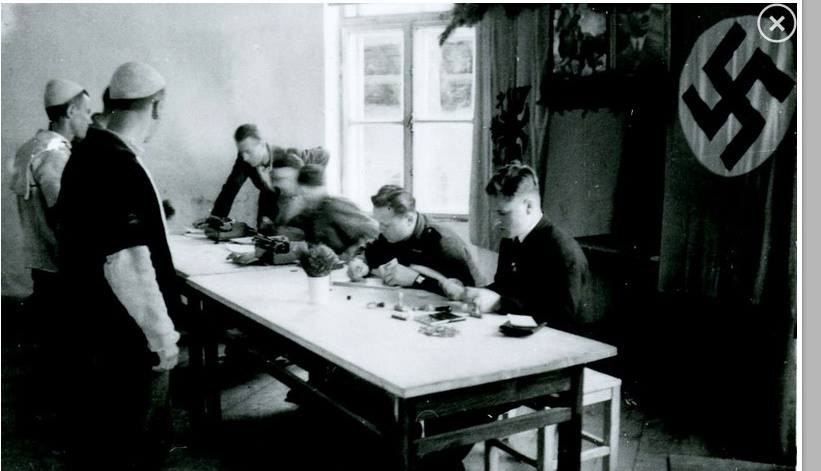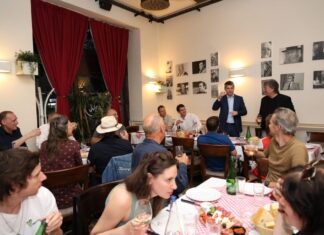|
Greater Albania under Nazi GermanyDuring World War II, 35,000 to 40,000 Kosovo Albanians were recruited by Nazi Germany as part of the German occupation forces and security formations in Greater Albania, a state created by Adolf Hitler and Benito Mussolini that included Kosovo-Metohija, western Macedonia, and territory from Serbia and Montenegro. In Albania, there were 30,000 Albanians who were in the German occupation forces. In 1941, the German occupation forces created a Kosovo Albanian Gendarmerie with headquarters in Kosovska Mitrovica. In 1944, these forces were incorporated into the Skanderbeg Nazi SS Division. In 1942, Balli Kombetar organization battalions were established by the German forces, which existed until 1945. In 1943, a Kosovo Regiment was created in Kosovska Mitrovica made up of Kosovo Albanians by German forces. In 1944, these troops were also incorporated into the Skanderbeg SS Division. The German forces also established the Pec and Pristina Territorial Police Regiments from 1944 to 1945. The Albanian Macedonian Militia was created in Macedonia in 1943-1945.
Most of the Albanian Nazi collaborationist forces were made up of Albanian Muslims from Kosovo-Metohija. The Nazi-created Gendarmerie, the special police, the paramilitary formations, the militias, and the Ushtars, Albanian security forces, were mostly from Kosovo-Metohija. It was only the Albanian Army that was made up of Albanians from Albania.
After the Italian surrender on September 8, 1943, the construction of a Nazi German Greater Albania began. This effort was led by Hermann Neubacher, and Franz von Scheiger and Martin Shliep of the German Foreign Ministry in Albania. Abwehr II or German Military Intelligence agents were also sent into Albania at this time. Three German divisions in the XXI Corps under General Hubert Lanz occupied Greater Albania. The 297th Infantry Division occupied Pristina and Prizren in Kosovo. The 100th Jaeger Division occupied Elbasan and Struga in western Macedonia. The 118th Jaeger Division advanced from Niksic and occupied the Albanian coastal areas.
|
The German plan to secure the occupation was based on Hermann Neubacher’s initiative to achieve “national mobilization”. Neubacher, who was from Austria, acted as the envoy of the German foreign ministry and was German Foreign Minister Joachim von Ribbentrop’s representative in Albania. This Nazi plan was to be realized by creating an Albanian Army that was led and organized by German forces. The Germans also sought to create an Albanian gendarmerie corps. They planned to arm and use certain Greater Albanian ultra-nationalist groups such as the Balli Kombetar. A Nazi Waffen SS Division in Kosovo made up of “Kosovar” Muslims was also created by Nazi Germany.Neubacher’s military adjutant attached to Abwehr II, Captain Lange, sought to create an Albanian national militia of 30,000 which would be a reserve force. The Germans were able to find collaborators with the Roman Catholic Albanians in the Mirdita region of northern Albania. They had been collaborators with the fascist Italian forces and with the Austro-Hungarian forces in World War I. They were able to open the Prizren to Shkodra road for German forces. Gjon Marka Gjoni, the leader of the Roman Catholic Albanian Ghegs in the Mirdita, stated that: “The Germans have been my friends. To betray my friends is immoral.” They remained Nazi Germany’s closest allies. The Germans provided them with weapons and paid them for this collaboration.
|
Another group the Germans collaborated with were the opportunistic Greater Albania ultra-nationalist Balli Kombetar (National Front), “Balisti” or “Balists”. The BK group was founded by Midhat Frasheri with the single objective of annexing Kosovo to a Greater or Ethnic Albania. The BK was the key collaborationist group with the Nazis in Kosovo. Bernd Fischer noted that “the Germans did win the cooperation of many BK cetas”. This disproves the pro-Albanian propagandistic historiography which seeks to portray the BK as anti-Nazi and anti-fascist. The key to the German occupation was making Kosovo-Metohija a part of Greater Albania. That was the linchpin of Nazi policy. As long as Nazi Germany supported Kosovo as a part of Greater Albania, they would have Albanian support.The head of the Gestapo in Kosovska Mitrovica in northern Kosovo was Gunther Hausding. The Germans established Kosovo Albanian Gestapo agents who were part of the fascist Albanian Committee. Perijuc Mamut, Ramiz Mulic, and Osman Ibrahimovic were Kosovo Albanian agents of the Gestapo who seized and looted Jewish property and businesses in Kosovska Mitrovica. This followed an order by Dzafer Deva, the president of the Kosovska Mitrovica district, that Jewish property be seized and that commissioners be appointed by the Albanian Committee to oversee Jewish businesses. Ibrahimovic ordered the destruction of the Jewish synagogue.
Jewish survivors of the Holocaust in Kosovo-Metohija place responsibility for the genocide against Jews in Kosovo on the fascist Kosovo Albanian Committee. The members were Rushid Mehmet, Sahsivar Alic, Husen Pristina, Tahir Kaldziu, Malus Kosova, and Sadik Galimuci. They incited the first and second waves of arrests of Jews in Kosovo-Metohija. Miljus Kosova was the president of the Albanian Kosovo Committee. Dzemal-beg Ismail Kanli was the chief of police. Rashid Mehmed Ali was the president of the district. Rifat Sukri Ranadan, Jahnja Asan, and Mahmud Saban Pasic were also members of the Committee.
|
There were several internment or prison camps set up in the Albanian cities of Preza, Berat, Kavaja, Burrel, Lakosnik, Shijak, Elbasan, and Kruja, where Kosovo Serbs and Jews were sent. In April, 1942, 100 Jews from Pristina were transferred to the prison camp at Berat, while 79 were transferred to Preza. In July, 1942, 88 Jews were transferred from Pristina to the prison camps at Burrel, Kruja, and Kavaja in Albania. There were also prisons in Pristina and Kosovska Mitrovica. According to Fischer, of the 400 Kosovo Jews sent to Bergen-Belsen, about 100 survived.Josip Josifovic, a Kosovo Jew, recalled the Albanian role in the Holocaust in Kosovo. He stated that “Albanians brought us more harm than the Germans did as occupiers.” He recalled that the Albanians interned the Kosovo Jews and sent them to the Berat prison in Albania in 1942. On their work documents the word “Jude” was stamped and they had to wear a yellow card.
|
There is overwhelming evidence that proves the Balli Kombetar collaborated with the German forces. Based on NARS Microfilm T-501, Roll 258, Frame 000628, the Balli Kombetar “would be courted by the Germans and…they would throw their support on the German side.” The new Nazi-created government for Greater Albania gained the support of the BK. Steve Kane noted that “the remnants of the Balli Kombetar entered into open collaboration with the new government.”All of the officers in the Albanian Fascist battalions were Italians while the NCOs were a mixture of Albanians and Italians. The 1st Legion was stationed in Tirana while the 2nd Legion was at Korce, the 3rd at Valona, and the 4th at Scutari. They were dissolved in 1943. They were battalion strength in size. Many of them were later incorporated in the German occupation forces. They wore Italian blouses, Italian helmets, and a collar tab described as a flame or Fiamme which showed a goat’s head. This was the goat’s head symbol of Skanderbeg. In the fascist Albanian Militia forces, members wore helmets with the goat’s head symbol over the “V” symbol, which was the emblem for fascism. Italian M33 helmets and captured French helmets were also used.
|
The Albanian Gendarmerie and the civil administration welcomed the Nazi German occupation in 1943. Albanian Muslim hodzas or clerics were photographed in Islamic prayer services for the Nazi forces. They supported the Nazis because they would put them in control of Kosovo.In September, 1943, the Germans sent the 100th Jaeger Division to occupy Tirana. This was the beginning of the German military occupation of Albania. The 92nd Independent Motorized Grenadier regiment was also sent. In September, 1943, the 181st Infantry Division, the 297th Infantry Division, and the 21st SS Division Skanderbeg were meant to garrison Albania.
In October, 1943, the Germans sent three Feldkommandanturen numbered 1030, 1039, and 1040. This was the beginning of the German attempt to create an Albanian Gendarmerie or police or security apparatus. These were sent to Tirana, the capital of Greater Albania, Prizren in Kosovo, and Struga in Macedonia. A German Plenipotentiary in Albania or DGA was created. The post was given to Oberst Dr. Westphal, whose duty it was to coordinate German military moves in the country with those of the Albanian collaborationist civil and military authorities. The members of Albanian Gendarmerie were known as Ushtars and they wore collar tabs that were red while the uniform was green. The emblem on their caps was the goat’s head symbol of Skanderbeg which was worn in metallic.
|
An Albanian militia formation, wearing Italian uniforms, consisting of a battalion of 600-700 Albanian volunteers from Kosovo, was formed by Nazi Germany under Hermann Neubacher. Neubacher sought to use them to safeguard German lines of communication in Kosovo and Albania. The battalion was under the command of Albanian Lieutenant Colonel Adem Boletini. The Germans trained the battalion in Zemun, then part of the Nazi-created Ustasha NDH. Neubacher even contemplated having the battalion occupy Tirana. In September, 1943, the Germans redeployed the battalion to Tirana.Dzafer Deva, the Kosovar Albanian Muslim Interior Minister of Greater Albania, redeployed 1,200 Albanian Gendarmes from Kosovska Mitrovica to Tirana in December, 1943. The SS Leader in Albania Josef Fitzthum was in control of the Albanian security forces, which were described as “a thoroughly undisciplined version of storm troopers.” These Nazi Kosovar storm troopers “ravaged the countryside”. It was an example of “Kosovar brutality”. The Germans provided 14,000 rifles and 425 machine guns and funds and supplies to the Kosovo Albanian security forces.
The Germans sought to create a Nazi-led Albanian gendarmerie force and an Albanian Army. General Gustav Fehn, the commander of the German XXIst Corps and SS Leader Fitzthum organized the formation of the Albanian Army. Heinrich Himmler had initially sent Fitzthum to Albania to provide expertise on security and police matters. Fitzthum had been born in Loiersdorf, Austria on September 14, 1896. He died in an auto accident on January 10, 1945 in Vienna. He had joined the SS in April, 1932. He had earlier commanded the SS Volunteer Legions “Flandern” and Niederlande”. In 1945, he was the commander of the 18th Volunteer Panzergrenadier SS Division “Horst Wessel”.
|
Josef Fitzthum was the Higher SS and Police Leader in Albania, Hoherer SS und Polizei Fuehrer “Albanien”, with a headquarters in Tirana from August 1, 1944 to January 1, 1945. He had originally been the SS und Polizei Fuehrer “Albanien” from October, 1943 to August 1, 1944. He was also the Beauftragter des Reichsfuehrer SS fur Albanien, Heinrich Himmler’s representative in Albania, from October, 1943 to January 1, 1945.The German plan was to create an Albanian Army consisting of 8,250 men. The Gendarmerie was to consist of 2,400 men.
Fitzthum, who had been an oberleutnant in the Habsburg Austro-Hungarian Army during World War I, planned to create an Albanian Waffen SS Division. This would be based on the Albanian Legion formed during World War I as part of the Austro-Hungarian Army. Himmler wanted to revive the Austro-Hungarian recruitment of Balkan Muslims from World War I. Bosnian Muslims, Albanian Muslims, and Sandzak Muslims had been part of the Austro-Hungarian Army during World War I. Himmler, thus, strongly backed the creation of an Albanian SS Division. SS General Ernst Kaltenbrunner, the head of the SD, Neubacher, and the German Foreign Ministry in Albania, opposed the plan.
|
In February, 1944, Adolf Hitler approved the formation of the Skanderbeg Division “because the Albanian government itself favored the plan” and because German occupation forces in Greater Albania needed more manpower. Bedri Pejani had even written Himmler personally to request that an Albanian Nazi SS Division be formed. According to Fischer, the “’Skanderbeg’ Division was to serve only in Kosova and was to protect ethnic Albania.” This is incorrect. The Skanderbeg Division was deployed to Kosovo, but also in Montenegro and Macedonia. The division became notorious for massacres of Kosovo Serbs. Fischer noted: “Units of the division gained an unenviable reputation, apparently preferring rape, pillage, and murder to fighting, primarily in Serbian areas.” According to Fischer, the Germans arrested Albanian officers in the SS Division at Pec and Prizren due to war crimes against Kosovo Serbs. Those arrested were sent to the Pristina prison and to incarceration in Germany. The Skanderbeg Division thus engaged in the genocide of Kosovo Serbs.
|
The Final Solution in KosovoThe Skanderbeg Division also contributed to the Final Solution, playing an important role in the genocide of Kosovo Jews. There was a Jewish presence in Kosovo. Based on 1931 population statistics for Yugoslavia, there were a total of 488 Jews in Kosovo-Metohija: 373 in Pristina, 109 in Kosovska Mitrovica, and 6 in Djakovica. In Pristina, the Beth Israel synagogue had been built in 1897. In Kosovo, the Skanderbeg Division rounded up the 281 Jews who were sent to the camp at Pristina and later to Bergen Belsen where they were killed.
The first operation of the Skanderbeg Nazi SS Division was to round-up 400 Kosovo Jews in Pristina on May 14, 1944. From May to June, 1944, Skanderbeg rounded-up 519 Kosovo Serbs and Jews. Haim Solomon, a Kosovo Jew from Lipljan, described how he was apprehended by the Skanderbeg SS Division:
I was captured on May 14, 1944 by troops of the SS division “Skanderbeg” which was made up of Albanian soldiers, but whose officers were German. All of us in Lipljan were captured only after a few hours after the Jews of Pristina were rounded up. From Pristina we were transported to the prison in Kosovska Mitrovica where we stayed for three weeks.
|
Solomon was sent to the Bergen Belsen concentration camp. On April 23, 1945 he was freed by advancing Soviet troops when prisoners from the camp were transported by rail to Czechoslovakia.Josip Levi, a Kosovo Jew from Pristina, recalled how he was captured by the Skanderbeg division:
They captured us on the night between May 13 and 14. The round-up of us Jews in 1944 in Pristina began in the night, exactly at midnight, and lasted until eight the next day…Our round-up was conducted by the SS division “Skanderbeg” which consisted of Albanians from Kosovo and Metohija, particularly from Drenica, but the officers were German. We were captured based on addresses which the Germans had received from the Albanian fascist civil administration. In Pristina we were put in a “G” wagon, a cattle wagon, and sent to the “Sajmisate” prison in Zemun, which was under the control of “SD” police, but where the Ustasha was in charge of the administration and security.
Levi was sent to Bergen Belsen. He survived and was able return to Pristina.
Genocide against Kosovo Serbs
The ethnic cleansing and genocide committed against the Kosovo Serbs is described by Bernd Fischer as follows:
The wholesale expulsion of Serbs by the Albanians created special problems for the occupation, however, since the Serbs had performed important functions in Kosova. The Serbs had run most of the businesses, the mills, the tanneries, and the public utilities. Once the Serbs had gone, there were no pharmacists in Kosova. Serbian peasants, somewhat more technologically progressive than their Albanian counterparts, were responsible for much of the surplus agricultural production for which Kosova was so useful.
|
Bedri Pejani, the president of the Nazi-created Second League of Prizren, a revival of the ideology of Greater Albania, wanted 150,000 weapons from the German forces to be used to kill and drive out the remaining Serbian population in Kosovo-Metohija. The expulsion of Serbs is described as follows by Fischer:By April 1944, German documents tell us, 40,000 Serbs had been forced to leave, and Neubacher anticipated that the Germans might have to deal with as many as 150,000 Serbs leaving Kosovo.
The policy of genocide against the Kosovo Serbian population had been officially announced in June, 1942, by Albanian Muslim Mustafa Kruja, the fascist Prime Minister of Greater Albania:
The Serbian population of Kosovo should be removed as soon as possible. Serbian settlers should be killed.
Albanian Gendarmerie under Nazi Germany
In August, the DGA office and its command were integrated into the Higher SS and Police Leader “Albania” under the command of SS Gruppenfuehrer und Generalleutnant der Waffen SS Josef Fitzhum or Fitzthum. SS Oberfuehrer Karl Gstottenbauer of the German Consular Office in Tirana was also to be attached to the HSSPF command. Fitzthum reorganized the Albanian Gendarmerie and the Army. By April, 1944, the total Albanian forces raised were two Jaeger light infantry regiments and four militia battalions.
The Albanian Order of Battle was as follows:
1. Albanian Jaeger Regiment 1
2. Albanian Jaeger Regiment 4
3. Albanian Militia Battalion “Pec”
4. Albanian Militia Battalion “Pristina”
5. Albanian Militia Battalion “Prizren”
6. Albanian Militia Battalion “Tetovo”
Three of the battalions were set up in Kosovo-Metohija, while the fourth was set up in Macedonia, known as Illirida in the Greater Albania ideology. According to German military sources, these formations were under the German Order Police or Orpo and were fighting the guerrillas. These four militia battalions were made up of 2,000 men and were under the command of Hauptmann der Schutzpolizei Spruny.
|
The Skanderbeg Waffen SS Division was also being formed with recruits from Kosovo and central and northern Albania. The Balli Kombetar (Shqip, National Front) also provided men for this Nazi SS Division. Between July 14 and 30, 1944, the 1st and 2nd Battalion/1st Regiment and its 1st battalion/ 2nd Regiment performed field maneuvers south of Berane in Montenegro and near Gusinje. The four militia battalions also participated in these maneuvers as did the 14th Mountain Regiment of the Prinz Eugen Division.General Gustav von Myrdacz (1874-1945), a former Austrian officer who commanded the pre-World War II Albanian Army under Zog, was put in charge of the reorganized Albanian security police, but was captured by Communist guerrillas. Myrdacz was the liaison officer between the Albanian Army and the XXI Army Corps. He joined the Albanian Army in 1921 and became chief of staff by 1925. He had been an engineer-officer on the staff of the Austrian Army. He was a highly decorated military officer. He was awarded four Austrian orders, one Turkish war decoration, and a Grand Cordon of Skanderbeg Order from the Albanian government. During World War I, he had been the chief of staff of the XIVth division and had commanded a regiment at Tonale. He had been the chief of staff of the military commander in Sarajevo. He was involved in the engagements at Isonzo and Piave in 1917. After Myrdacz was captured, Albanian General Prenk Previsi was put in his place.
Once it became clear that Nazi Germany would lose the war, the Albanian Gendarmerie and militia battalions began deserting and switching sides.
The German occupation forces were better able to use the Albanian security and military forces than the Italians. German occupation forces were able to integrate Albanian forces into their security and military forces. Moreover, German policy was able to fully exploit the Albanian nationalist and political objective to achieve a Greater or Ethnic Albania first envisioned and enunciated by the 1878 League of Prizren. Nazi Germany revived the League of Prizren in 1943. The key to the Nazi occupation was to maintain the collaboration of the Balli Kombetar and the Albanian population by advocating a Greater Albania that would include Kosovo-Metohija. This was the crux to Nazi policy. Kosovo was the key.
|
Greater Albania RealizedThere was widespread Albanian popular support for the Nazi occupation regime. Nazi Germany and Adolf Hitler allowed Albanian nationalists to create a Greater or Ethnic Albania. This had been an unrealized goal of Albanian nationalism since the League of Prizren in 1878. Greater Albania was realized by Nazi Germany. Kosovo was thus crucial in Nazi policy. Making Kosovo a part of Greater Albania was crucial to maintain the Nazi German occupation.
The Nazi realization of Greater Albania had implications and political repercussions for the future status of Kosovo. Albanian ultra-nationalists had a precedent and a model for Greater Albania. Adolf Hitler and Heinrich Himmler showed them how to realize a Greater Albania. The history of a Greater Albania from 1941 to 1945 under Nazi Germany is covered-up and censored in the US and the so-called West. Consequently, it is not known that Kosovo was “independent” under Adolf Hitler and Heinrich Himmler. Kosovo was annexed to a Greater Albania from 1941 to 1945.
Albanian popular support for fascism and Nazism was widespread. Nazi Germany exploited the Greater Albania nationalist ideology to gain popular support for the Nazi German occupation of Kosovo. Bernd Fischer noted that “numerous Allied sources give evidence of widespread support for the Germans and their government. In the north and northeast support was widespread.” The Nazi creation of a Greater Albania that incorporated Kosovo-Metohija would have future political repercussions and implications.
Bibliography
Fischer, Bernd Jurgen. Albania at War, 1939-1945. West Lafayette, IN: Purdue University Press, 1999.
Ivanov, Pavle Dzeletovic. Jevreji Kosova i Metohije. Beograd: Panpublik, 1988.
Kane, Steve. “The 21st SS Mountain Division”. Siegrunen. Volume 36. October-December 1984.
Munoz, Antonio, ed. The East Came West. NY: Axis Europa Books, 2001.
Trye, Rex. Mussolini’s Soldiers. Shrewsbury, UK: Airlife, 1995.
http://www.serbianna.com/columns/savich/071.shtml



























